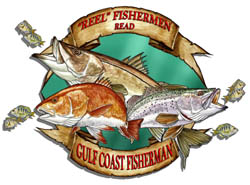
The Saltwater Magazine for Gulf Coast Fishing!
FISHING FORECASTS | FISHING CALENDARS | ARTICLES | ADVERTISE | SUBSCRIBE
Search Gulf Coast Fisherman's
Web Site
Past articles, specific
places or fish, etc.

Pulling the Triggers (Trigger Fish That Is...)
by Capt. Mike Holmes
Fall 1997
![]()
| CURRENT
MOON lunar phases |
GULF COAST
FISHERMAN T-Shirts
GCF
T's are here!
The fall and winter are a great time to fish offshore. Even though many of the migratory species have departed for deeper water or warmer climates, bottom fishing for snapper and grouper is actually reaching its annual peak. Unfortunately, populations of hungry triggerfish are also peaking. When large schools of "triggers" are cruising the surface, getting a bait down to snapper can be difficult to impossible using standard bottom fishing methods and tackle. For those willing to differ a bit from the norm, however, there are techniques that can make the difference between a frustrating outing and a full fish box.
The first, and most simple tactic to try involves the opposite of two extremes in baits and sinkers. When triggerfish are only moderately bothersome, using heavier sinkers than normal can sometimes pull baits past them fast enough to escape destruction. I primarily use 4 to 8 ounces of lead when bottom fishing in 100 foot water, depending on current strength, but as much as 12 to 18 ounces may be necessary to avoid the triggers.
* * * * *
My friends Danny Stanley and Rene Morales use light spinning gear to accomplish the same task, and have more fun in the process. Rigging up with just enough sinker to get down through the current - light mono leaders, small hooks, and live shrimp for bait - they have had excellent results on cool weather snapper.
Of course, sometimes the triggers will follow even a fast sinking bait to the bottom. A variation that works in this case is to use casting gear - either a big spinner or a revolving spool reel on a fast taper rod - to cast a bait as far behind the boat as possible, beyond the patrolling zone of triggerfish "scouts." By the time the bait swings through its arc to the bottom, it will be in position roughly beneath the boat. A short, single hook leader and sinker light enough for easy casting make this trick feasible.
Live baits, especially larger ones, will sometimes survive the onslaught of the triggerfish. We have successfully used finger mullet, mud minnows, and even the goldfish carp sold as freshwater catfish bait. Blue runners, piggies, and vermillion snapper will work, but are normally used when after sow snapper, grouper, or amberjack.
Another good technique is to try artificial lures. Big metal jigs, large soft plastic lures and heavy spoons can be dropped to snapper depth, jerked upwards, and allowed to flutter back down. The triggers might still attack, but they can't eat metal, and their small mouth will keep them off the hook.
Sometimes it is best not to hook to the rig or anchor over structure. A controlled drift begun upcurrent of triggerfish in- festations will allow baits to reach bottom unmolested. Some anglers use downriggers to control the fishing depth, or to slow troll bait or lures. Anchoring upcurrent and drifting a deep chum trail can bring fish to the boat - away from pesky surface feeders.
As a last resort, when triggerfish are so thick and hungry they eat part of the styrafoam dive flag float like they did on my last dive charter trip - turn the tables and fish purposely for triggerfish! When in a feeding frenzy - which they almost always are - they can be ridiculously easy to catch with bait and small hooks or even jigs. Besides being tough fighters on light tackle, triggers are excellent eating. The firm, white flesh is even preferred to snapper by several experienced fishermen I know. Because the skin of these creatures is about equal to that of the average African bull elephant, and the bone structure could support highway overpasses, many anglers get discouraged by the relatively small amount of meat a trigger yields.
While triggerfish are considered pests by most Gulf Coast fishermen, they are not without their advocates. The U. S. government likes triggers so much, for instance, that the National Marine Fisheries Service lists new limits on this species. That's right, limits on triggerfish. In the South Atlantic fishery, a 12 inch minimum limit has been in effect for gray triggerfish for some time.
Closer to home, triggerfish have been included in the 20 fish "reef fish aggregate" limit recently enacted for the Gulf of Mexico. What this means in real world terms is that any "reef fish" which do not have individual possession limits must be lumped together for a combined daily limit of 20 fish. In effect, this means that snapper other than red snapper - lane, vermillion, mutton, silk, big-eye, cubera, dog, gray, queen, and yellowtail - and triggerfish are grouped together, and no more than 20 fish from this group - of any combination of species - may be kept per angler per day. Keeping too many triggerfish might be the last thing most anglers would worry about, but for those who do like to eat a few, a count should definitely be kept.

